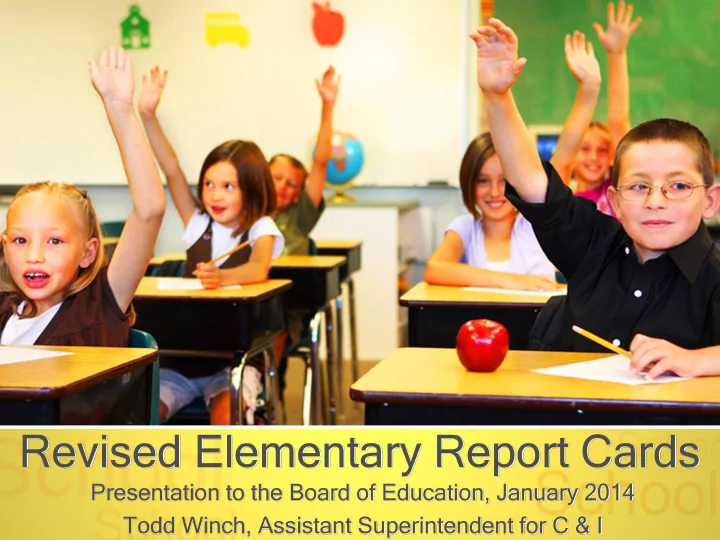

Revised Elementary Report Cards Presentation to the Board of Education, January 2014 Todd Winch, Assistant Superintendent for C & I
Reasons for Change • Current Report Cards are cumbersome and difficult to read. • Changes in curriculum due to the adoption of the Common Core Standards necessitates a change in the language of the report cards. • Opportunity to realign our elementary reporting timelines with our RTI model.
Revision Process • Report Card Committee established in February 2013. • Reviewed over a dozen report cards from across L.I., N.Y.S. and the nation. • Used the Common Core Standards as a foundation. • Used easy-to-understand descriptors.
Underlying Principles of the Committee • Focus: Report Card is a tool to deliver progress information to parents and students. • Use language and/or reporting elements that are familiar to parents and students: – Levels 1,2,3,4 – Grade Level Equivalency charts for upper grades – Universal layout for all grades K-5
Current Reporting Structure • Progress Report distributed in November. • For grades 1-5, three report cards distributed in January, March and June. • For grade K: Two report cards in January and June. • Report cards for grades K-2 are completely different than report cards for grades 3-5. Goal: Move to a trimester reporting system with comparable report cards K-5 for 2014-2015.
Overview of Changes Aspect ct Previ vious ous New Reportin rting g Meth ethod od Reportin rting g Meth ethod od First st Report rt Card Issued ued January ary November mber Number er of Report t Cards Three ee Three ee (+ 1 progress ress report) rt) Simila lar r Report rt Card for grades s K-5 No No Yes Number r of Marking ing periods Four Three Report rt cards s include all grades s and No No Yes comme ments nts from m previo ious s marki king ng period ods Parent nt Guide e provid ided d with h Report rt No No Yes Card
Benefits to Moving to Trimester Grading • The first student report card will be distributed in November instead of January. • Occurs three times a year, similar to RtI process. • Same indicators are used throughout the year. • One reporting instrument will be used for students’ entire elementary experience.
Other Districts using Trimester Grading • Baldwin • Levittown • Bellmore • Long Beach • East Williston • Massapequa • Franklin Square • Mineola • Glen Cove • Plainview • Great Neck • Roslyn • Garden City • Seaford • Jericho • Wantagh
Sample front
Sample back
Moving Forward • Report cards will be piloted Jan-June 2014. • Letters and “Parent’s User Guide” will accompany first report card and will be available on the district website. • Principals will discuss new format at Coffee Hour and PTA meetings. • Feedback will be collected for additional modifications over the summer. • Marking periods will be adjusted in 2014-2015 for Trimesters • At first Parent/Teacher conference, teachers will distribute report cards and NWEA results.
Recommend
More recommend